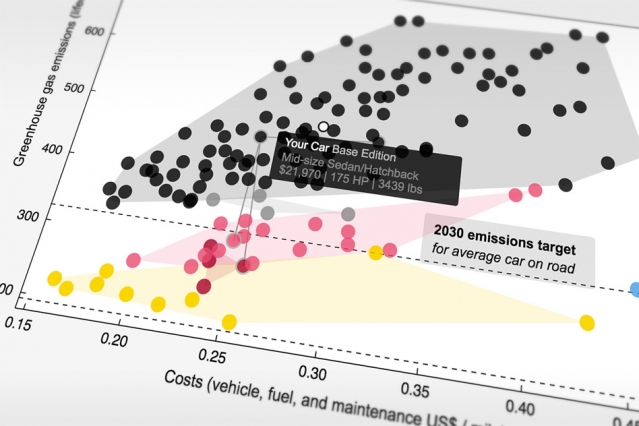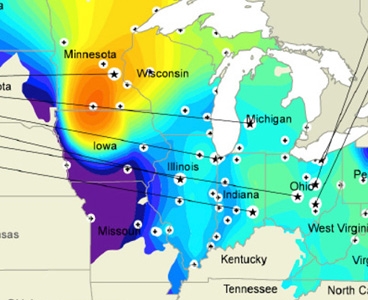Energy Systems
A growing global population presents challenges in meeting the increasing demand for energy and the development of the underlying infrastructure that provides critical services and utilities, such as power and communications, as well as natural resources, like water. IDSS is interested in the operation of energy systems, technological and institutional innovation, and understanding the environmental and broader sustainability impacts of energy consumption.
IDSS focuses on research that advances our understanding of these systems, and how new sensors and analytics will provide smart services—as well as how we can ensure better management and reliability in the future. For example, the development of power grids around the globe is being driven by environmental and economic factors, and is evolving rapidly to incorporate diverse technologies in renewable and distributed power generation. The successful integration of these resources, which are inherently uncertain, volatile, and governed by fundamentally different economics, requires rethinking of the architecture of electricity markets. In parallel, the abundance of modern sensing, communication, and actuation technologies presents an unprecedented opportunity for organizing these new components under a robust, efficient, and secure architecture for communication, computation, and control. Modern power grids must operate efficiently under normal operating conditions and be capable of withstanding severe disturbances in a highly dynamic and uncertain environment. IDSS research will address these problems through the development of systematic modeling and analysis methodologies, as well as architecture design frameworks for future systems.
Read more about IDSS research in energy systems in this article: “Addressing energy technologies and policies that shape future sustainability” (IDSS / MIT News).
Examples of topics in this domain include:
- How do we develop models and metrics to quantify the effects of uncertainty and variability of renewable resources on the robustness and efficiency of power systems?
- How do we design robust, efficient, and fair energy markets consisting of a large number of heterogeneous resources with different output characteristics in terms of uncertainty, variability, and cost basis?
- How do we incorporate demand response in the operation of power systems? How can we create better incentives for individuals and organizations to provide more reliable demand response by developing a deeper understating of human and organizational behavior?
- How do we model, analyze, and predict cascaded failures? How do we measure risk and distance to failure, and how do we reconfigure the system to avert failures?
- How can big data help in developing a risk assessment modeling and forecasting tool for energy systems?
- How can we develop abstracted models that capture the most essential aspects of power systems: power flow constraints, incentives, controls, and protocols that influence behavior? How can we incorporate such models in a theoretical framework for the design of an efficient and reconfigurable architecture?
Audun Botterud
Botterud’s research focuses on the integration of renewable energy and energy storage into a smarter electric grid. More broadly, his research aims to improve the understanding of the complex interactions between engineering, economics, and policy in electricity markets—ultimately enabling a transition towards more cost-efficient and reliable low-carbon energy systems.
Jessika Trancik
Trancik and team have been awarded a grant of nearly $1.3 million through the U.S. Department of Energy’s SunShot Initiative to study the reasons for solar energy’s rapid and sustained cost decline and how to continue reducing costs in the future. The awarded project, which will examine features of photovoltaic (PV) devices, public policies, and private sector efforts, is titled “Modeling Photovoltaics Innovation and Deployment Dynamics.”
Jessika Trancik
Study by MIT researchers shows that when operating and maintenance costs are included in a vehicle’s price, autos emitting less carbon are among the market’s least expensive options, on a per-mile basis.
Noelle Selin
A paper co-written by Noelle Selin finds that the more than 167,000 piston-engine aircraft that comprise the majority of the U.S. general aviation fleet may pose a significant health threat. These vehicles, which rely on leaded fuel to operate safely, constitute the nation’s largest remaining source of lead emissions.
Munther Dahleh, Sanjoy Mitter, Mardavij Roozbehani
The increasing demand for energy along with growing environmental concerns have led to a national agenda for engineering modern power grids with the capacity to integrate renewable energy resources on a large scale. In this paradigm shift, demand response and dynamic pricing are often considered a means of mitigating the uncertainties of renewable energy generation and improving the system’s economic and environmental efficiency. However, this real-time coupling of supply and demand creates significant challenges for guaranteeing reliability and robustness in the power system. This research addresses these challenges by providing a framework for modeling and analysis of the dynamics of supply, demand, and clearing prices in a power system with real-time retail pricing and information asymmetry.
Munther Dahleh, Mardavij Roozbehani
In order to study the impact of dynamic demand response on the future smart grid, IDSS researchers used an abstracted model to examine how a tradeoff between efficiency and risk arises under different market architectures. The first part of the study explored system performance under non-cooperative and cooperative market architectures. The statistics of the stationary aggregate demand processes showed that, although the non-cooperative load scheduling scheme leads to an efficiency loss, the stationary distribution of the corresponding aggregate demand process has a smaller tail, resulting in less frequent aggregate demand spikes. Cooperative dynamic demand response, on the other hand, makes the marketplace more efficient at the cost of increased risk of aggregate demand spikes. Thus, the market architecture determines the locus of the system performance with respect to the tradeoff curve.
John Tsitsiklis
In an electric power system, demand fluctuations may result in significant ancillary cost to suppliers. In the near future, deep penetration of volatile renewable electricity generation is expected to exacerbate the variability of demand on conventional thermal generating units. IDSS PI John Tsitsiklis and his collaborator Yunjian Xu propose a dynamic pricing mechanism that explicitly encourages consumers to adapt their consumption so as to offset the variability of demand on conventional units. Through a dynamic game-theoretic formulation, they show that their proposed pricing mechanism achieves social optimality asymptotically, as the number of consumers increases to infinity. In addition, their results demonstrate that compared with marginal cost pricing, this proposed mechanism creates a stronger incentive for consumers to shift their peak load, and therefore has the potential to reduce the need for long-term investment in peaking plants.










